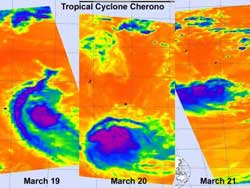NASA infrared satellite imagery shows Cyclone Cherono dwindling

These three days of AIRS infrared imagery show how wind shear took its toll on Cyclone Cherono and weakened it to a remnant low pressure area. On March 19 (left) it was a tropical storm with a band of thunderstorms around west of center. On March 20 the banding was gone and strong convection (purple) was limited to north of the center of circulation. By March 21 Cherono had become asymmetric from wind shear and weakened to a remnant low. Credit: NASA JPL, Ed Olsen<br>
NASA's Aqua satellite flew over former Tropical Cyclone Cherono each day over the last three days and the Atmospheric Infrared Sounder (AIRS) instrument captured the effects of the increased wind shear in infrared imagery.
AIRS infrared imagery on March 19 at 09:35 UTC showed a concentrated center of circulation with a band of thunderstorms stretching from southwest to northwest outside the center of Cherono's circulation. At that time Cherono was still a tropical storm. On March 20 at 21:11 UTC, AIRS imagery revealed that those bands of thunderstorms around Cherono had disappeared as a result of the increased wind shear. On Sunday, March 20, the strongest convection (rapidly rising air that forms the thunderstorms that power a tropical cyclone) was located to the north of the center of circulation.
By March 21 at 09:17 UTC, NASA AIRS infrared imagery showed that Cherono had become asymmetric from wind shear. When a tropical cyclone becomes asymmetric it weakens.
The Mauritius Meteorological Service warns that as the remnant low pressure area formerly known as Cyclone Cherono continues to move away today, March 21. As a result, rough surf and heavy ocean swells can be expected today and residents are being warned not to go in the ocean, especially beyond reef areas.
The last warning on Cherono from the Joint Typhoon Warning Center came on Saturday, March 19, when Cherono was still a Tropical Storm with maximum sustained winds near 40 mph (35 knots/ 64 kmh). at that time it was located about 595 miles east of La Reunion Island near 19.7 South and 65.0 East, and was moving west-southwest near 9 mph (8 knots/ 14 kmh).
Over this past weekend, vertical wind shear increased battering the structure of Cyclone Cherono and weakening the circulation. Now the remnant low continues to move away from Mauritius and is expected to dissipate over the next day or two.
Media Contact
More Information:
http://www.nasa.govAll latest news from the category: Earth Sciences
Earth Sciences (also referred to as Geosciences), which deals with basic issues surrounding our planet, plays a vital role in the area of energy and raw materials supply.
Earth Sciences comprises subjects such as geology, geography, geological informatics, paleontology, mineralogy, petrography, crystallography, geophysics, geodesy, glaciology, cartography, photogrammetry, meteorology and seismology, early-warning systems, earthquake research and polar research.
Newest articles

Superradiant atoms could push the boundaries of how precisely time can be measured
Superradiant atoms can help us measure time more precisely than ever. In a new study, researchers from the University of Copenhagen present a new method for measuring the time interval,…

Ion thermoelectric conversion devices for near room temperature
The electrode sheet of the thermoelectric device consists of ionic hydrogel, which is sandwiched between the electrodes to form, and the Prussian blue on the electrode undergoes a redox reaction…

Zap Energy achieves 37-million-degree temperatures in a compact device
New publication reports record electron temperatures for a small-scale, sheared-flow-stabilized Z-pinch fusion device. In the nine decades since humans first produced fusion reactions, only a few fusion technologies have demonstrated…





















